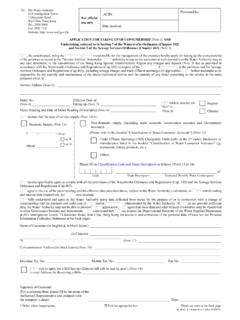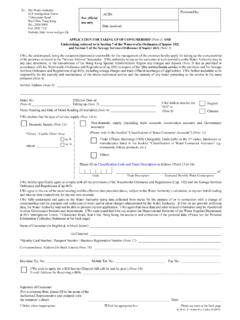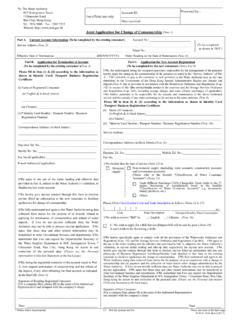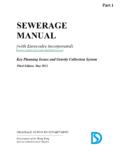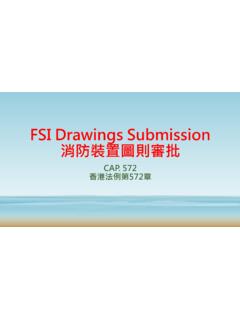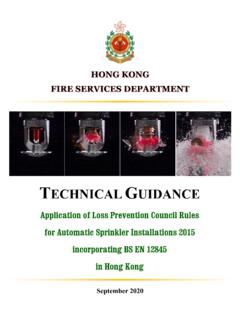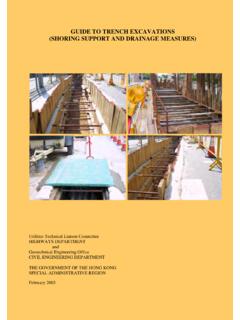Transcription of Best Practice Guidelines for Water Usage in Hotel Industry
1 Hotel Industry November 2016 English Version Best Practice Guidelines for Water Usage inIntroduction 2 Introduction The Government has promulgated the Total Water Management (TWM) strategy in Hong Kong putting emphasis on containing the growth of Water demand through conservation and strengthening our Water supply management. With a view to achieving sustainability of Water resources, in collaboration with all stakeholders concerned, Water supplies department (WSD) has been promoting Water conservation actively and providing support for non-domestic sectors to enhance their Water use efficiency, thereby reducing their Water consumption. To enhance Water use efficiency in the Hotel Industry , WSD has developed a set of Best Practice Guidelines (BPG) to the Industry practitioners for reference.
2 It is expected that the Hotel Industry could implement the Water use efficiency measures in their daily operation. Objective of BPG The aim of the BPG is to set out Water saving measures applicable to the Hotel Industry . The BPG summarises Water use efficiency practices for the local Hotel Industry operation, making reference to the experience of other countries. Measures for Enhancing Water Use Efficiency Water conservation can be achieved through adopting Water saving measures in different aspects of operation, including general operation, maintenance, hospitality service, kitchen operation, dining area operation, swimming pool, Water features and landscape management. Introduction 3 Best Practices - General Operation Encourage employees to make suggestions on Water conservation through a reward scheme Review the Water consumption data from Water bills regularly to establish Water saving measures and evaluate their effectiveness Install sub-meters to record Water consumption of high Water use entities for analysis of Water Usage Assign employee(s) to monitor Water use Educate employees / remind customers to enhance their awareness on Water conservation ( through providing appropriate training to staff and displaying Water saving notices / stickers at appropriate locations)
3 Best Practices -General Operation 4 aged Best Practices - Maintenance Inspect Water mains regularly and rectify leakage promptly Inspect taps and shower heads regularly and repair any dripping promptly Install flow controllers in plumbing fixtures Turn off taps and shower heads when they are not in use Retrofit aged appliances and fixtures with high Water use efficiency models Install automatic on / off sensors on taps Best Practices -Maintenance 5 Best Practices Hospitality Service Best Practices -Hospitality Service 6 Best Practices - Hospitality Service Encourage guests to support the Reuse Towel and Linen programme, and provide appropriate training to housekeeping staff. Turn off unnecessary taps when housekeeping staff is carrying out cleaning.
4 Report and promptly repair leaking faucets, shower heads, running toilets and toilets flushing poorly. Use opened bottled Water for irrigation. Do not replace unopened bottled Water in guest rooms unnecessarily. Replace bathtubs with shower cubicles and retrofit appliances with high Water use efficiency models whenever possible. Best Practices -Hospitality Service 7 Best Practices Kitchen Operation Best Practices -Kitchen Operation 8 Best Practices - Kitchen Operation Food Rinsing Wash vegetables in a basin of Water instead of under a running tap. Dish Washing Soak utensils and dishes in a basin of Water before cleaning for easy removal of food residues. Use pressure sprays to wash dishes effectively and reduce Water consumption.
5 Adopt suitable detergent and avoid excessive use of detergent. Turn off dishwashers when not in use. Run dishwashers with a full load. Recycle rinse Water from dishwashers to wash away food residues on dishes. For manual dishwashing, install 3-compartment washing basins for handling cleaning processes with different levels of Water consumption including soaking, washing and rinsing separately to reduce Water use and to recycle rinse Water more easily. Operation of Steam Cabinet Use condensed Water from steam cabinets for general cleaning purpose. Turn off steam cabinets if not in use during off-peak hours. Food Defrosting Natural Defrosting - Wrap frozen food in cling film and take it from the freezer to the refrigerator (0 to 4 oC ) for pre-defrosting.
6 Aerated Defrosting - Install an air pump to the defrosting sink to create currents which keep the frozen food rotating in the sink. The defrosting process can then be speeded up. This method can significantly reduce Water consumption compared with defrosting under a running tap. Best Practices - Kitchen Operation 9 Type of Wok Stove Water -cooled wok stove Water -cooled wok stove has one or more taps which are rarely turned off, for cooling the cooktop. These continuous running taps consume large amounts of Water . Wok burner chimney Constant flow of Water and ring fixed toneeded to cool surfaces cooktop Heat transferred to wok stove cooktop and structure Gas burner Heat trapped under wok Metal chimneystove cooktop Air-cooled wok stove The air-cooled wok stove consists of an air gap which isolates the cooktop from the wok ring and chimney, so that heat can escape via the gap and eliminate the need of Water to cool down the stove.
7 Air gap isolates cooktop from wok ring and chimney Heat escapes via air gap Gas burner Wok chimney and ring supported by structure below the burner Retrofit aged wok stoves with air-cooled wok stoves to reduce Water consumption. 10 Best Practices -Kitchen Operation Dishwasher Old Standard New Standard Water Saving Efficiency L/rack L/min 95-132 L/hr L/lb L/rack L/rack 6 L/min L/min L/hr L/hr L/lb L/lb Comparison between New andOld Models of Kitchen Appliances Steam Recovery Cabinet Pre-rinse spray valve Steam cabinet Ice maker Through the heat exchange process, transform the heat of emitting steam to heat energy. The heat energy collected can then be used to heat up tap Water which can be used by kitchen appliances like steam cabinets, dishwashers and heaters etc.
8 The steam can be transformed to condensed Water for general cleaning purpose. Retrofit aged kitchen appliances with high Water use efficiency models and steam recovery cabinets to reduce Water consumption. Best Practices -Kitchen Operation 11 Best Practices Dining Area Operation 12 Best Practices -Dining Area Operation Best Practices - Dining Area Operation Serve / refill Water only upon customers request Provide basic dining utensils and serve extra utensils only upon customers request Provide self-service drinking Water station for customers Replace bone plates and dining utensils only upon customers request Use powder cleaning agent to clean carpet instead of Water or steam Display Water saving notices to raise customers awareness on Water conservation Best Practices -Dining Area Operation 13 Best Practices SwimmingPool Operation 14 Best Practices -Swimming Pool Operation Best Practices - Swimming Pool Operation Check level sensors
9 And float gauges regularly to prevent overflow Use high efficiency tools, high pressure jets, for poolside cleaning Conduct regular reviews on the effectiveness of filtration plant Cover up the pools when they are not in service to minimise evaporation Best Practices -Swimming Pool Operation 15 Best Practices Water Features Management 16 Best Practices - Water Features Management Best Practices - Water Features Management Install wind sensors to turn off fountains automaticallyduring strongwind conditions to avoid Water loss from splash Check level sensors and float gauges regularly to avoid overflow Check level sensors and float gauges to avoid overflow Install appropriate filtration system to recycle Water and reduce Water consumption Best Practices - Water Features Management 17 Best Practices Landscape Management 18 Best Practices.
10 Landscape Management Best Practices - Landscape Management Select soil with high Water holding capacity for landscaping works Watering in the morning or evening instead of in the middle of the day to minimise Water loss through evaporation Inspect irrigation equipment regularly and repair any defects or leakage promptly Plants with similar Water requirement should be grouped and planted together Adopt efficient irrigation, automatic irrigation, to control Water consumption Best Practices -Landscape Management 19 Best Practices Checklist 20 Best Practices -Checklist Best Practice Guidelinesfor Water Usage inHotel IndustryChecklist 1/42016 7 Best Practices Checklist Best Practices - Checklist General Operation Yes/No Display Water saving stickers and posters at appropriate locations to educate staff and enhance customers awareness on Water conservation, and provide appropriate training to staff.


